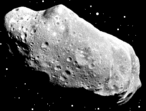By Bruce Johnston
The original pages have been copied to the MinorPlanet.info site to assure that they will be available (sometimes sites go away, which Bruce' site did). Credit should always be given to him when referencing this page.There seems to be a lot of confusion lately, as to what "drift alignment" is all about. What is it? How does it work? How does a person make use of it? With a little luck, I may be able to explain how it works, fairly painlessly. Once that's understood, using it from then on should be a breeze.
In the following discussion, I'll be emphasizing Drift Alignment as applies to a wedge mounted LX-200 or other SCT, but the principle for drift alignment is actually the same for all scopes. I'll just be using the LX-200 as a reference for where the user is looking, compared to the scope orientation, and what will be seen from that perspective.
Let me first say that Drift Alignment, like all polar alignment techniques, is used to get the polar axis of your telescope parallel with the polar axis of the Earth. Nothing more; nothing less. It's just that it's done by watching selected stars "drift" in Declination while viewing them. From the type of Declination drift, we determine in which way our scope is mis-aligned, and we can correct it accordingly. Thus, the name of "drift align"
There are really only two directions that your scope can be off. You can be either "left" or "right" of the Celestial pole in question, or you can be "above" or "below" it. Of course, you can be any combination of the two at one time, and it&apos:s very likely that, in fact, you are when you start. We'll see how the "drift" method is used to close in on both of these directions, one at a time.
I can also define polar alignment a slightly different way and it will still mean the same thing. Polar alignment is the act of setting up your telescope in such a way that the North end of its polar axis points toward the North Celestial Pole and its South polar axis points toward the South Celestial Pole. That seems as if I'm just saying the same thing but a little differently.... which I am... but if you keep that particular definition in mind as we progress, I think you'll find that it will make following discussion even easier.
Unfortunately, before we can look at the idea of "drift alignment", we had best get a couple of terms WELL understood! This part can get especially confusing if a person is looking directly through the eyepiece one time, then perhaps through a diagonal the next time. This isn't truly complicated, but if you're not careful, you could easily get confused, so we're going to elaborate on it.
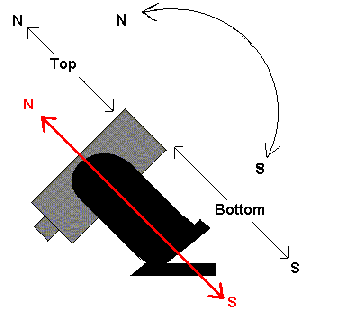
This drawing is a view of our scope as seen from its West side, when it's aimed approximately at the Celestial Equator and fairly near the meridian, as seen from a mid-latitude in the Northern Hemisphere.
Notice that the polar axis of the telescope runs right down through the center of the scope mount, more or less parallel with the forks. The SOUTHERN pole of the scopes axis aims down through the ground and at the Southern Celestial Pole, while the NORTHERN pole aims toward the Northern Celestial Pole.
What's even more important, is to notice that the direction of "North" is toward the physical TOP of our scope tube. The "top" side being that side where our finder scope is also mounted, more or less.
The direction of "South" is obviously in the opposite direction, and is toward the wedge, or down toward the forks.
I guess that it can be accepted that when I talk about aiming your scope "North" or "up", it means that the FRONT of the scope is going to be rotated in the direction of what we just defined as the "North" direction, or toward the TOP side of the scope tube! Likewise, aiming the scope "South" or down, means it will be moved in the direction of the WEDGE, or the BOTTOM of the scope tube!. Fair enough?
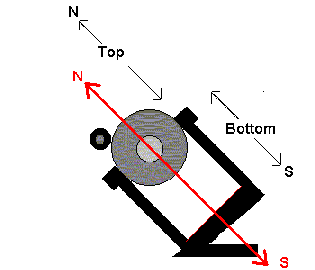
The tricky part is seen in this view. It also is a view of the scope as seen from its West side, but the scope is aimed EAST this time. It's still aimed near the Celestial Equator, but it's been rotated rather toward the EAST horizon! Things look a lot more different now, but the fact is, our rules are still in place. If the front of the scope is moved "up" or "North", the front of the scope will still be moved toward the TOP of the scope (where the guide scope is still located, more or less). Aiming the scope "South" or "down", will still mean pointing the front of the scope more toward the "bottom" of the scope, or toward the forks or wedge. This isn't so bad, is it?
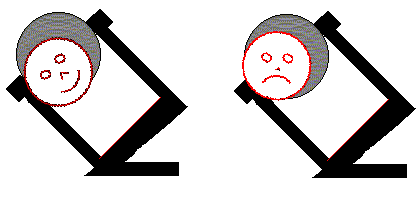
So long as viewers, when looking through the eyepiece, rotate their heads and align themselves as in the first image, things might seem okay. "Up" is still toward the top of their heads, even if it's not in the direction away from gravity. At least, it's "up" to these people.
But what about the viewers in the next picture? These people have simply stepped over to the eyepiece without any contortions. They are perhaps relatively short, or just don't want to rotate their heads at an angle. If the scope is to be moved "up", will these viewers see it move "up"? That is, will "up" still be toward the top of the viewers heads? NO! According to what we have just stated, "up" is defined as being toward that same part of the telescope as before, and "down" is toward the wedge! If the viewers were to see star movement in the eyepiece that was supposed to be "North" or "up", the viewers would see the star moving toward the "left" and "up", on a diagonal! That's because the viewers don't really understand what "up" and "North" is, as is used in astronomy.
It can get even worse. If a person is using a diagonal, then the appearance of the directions change, and movement of the scope and/or any object being viewed, can get even MORE confusing!
With all of this in mind, the point here is, be SURE of what you're seeing when you are looking for directional movement. Don't assume that just because an object is moving toward the sky over your head, that it represents "Up", "Down", "South", or "North". PROVE it ahead of time! You can do this by very gently pushing up on the front of the optical tube when you're aimed very nearly at your meridian.
The scope will move "up", or "North" ("South", if you're in the Southern Hemisphere) and the star being viewed WILL move the OPPOSITE direction, no matter what you see! This observation, and ONLY this observation, is the one that can be trusted for determining what direction the observed star is "moving".
Okay. The painful part is over. Let's get started.
Alignment for the Northern Hemisphere.
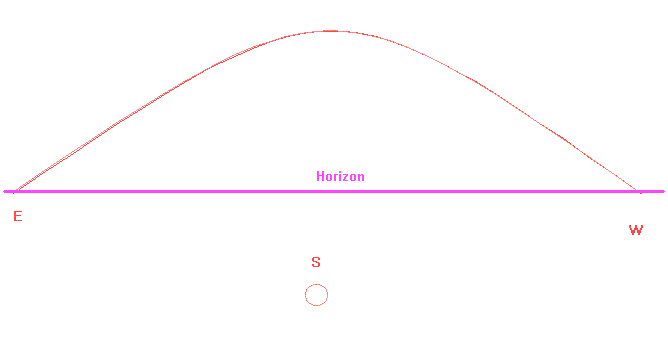
The above drawing is my feeble attempt at showing what the Celestial Equator would look
like to an observer at Northern mid-latitudes, when facing SOUTH. It is a
non-panoramic, two dimensional representation of a panoramic, three dimensional object.
The result is the sinusoidal shape you see here.
You see that the South Celestial Pole is significantly below the horizon. Naturally, the
North Celestial Pole is in the opposite direction, behind the viewer and somewhere
roughly half way between the horizon and overhead.
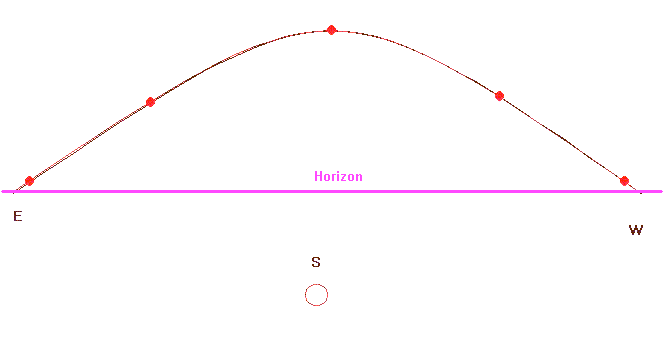
Here, we have a star that's following along the Celestial Equator as the evening passes. It rises in the East, passes our meridian, then sets in the West.
I believe it's safe to say at this point, that the star always stays the same "distance" from the South Celestial Pole throughout the night. This simply means that it stays at the same Declination! I realize that these terms are basic to amateur astronomers, but bear with me. The reason for terms as I re-define them, should soon become apparent.
Now it's time to set up the scope. You've got it as close to Polar aligned as you think it needs to be, so just aim it South and get ready to look through the eyepiece at our "star". This, of course, means that you, also, are facing South.
Never fear; for the folks in the Southern Hemisphere, we'll soon see things from your point of view. But follow along anyway. There are fewer images from your point of view.
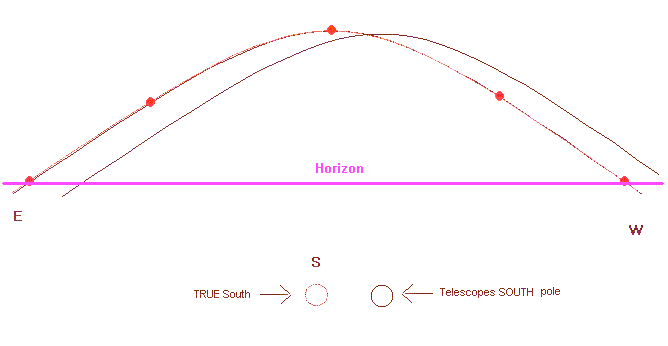
Ooops! From the looks of things, we aren't properly polar aligned, and we didn't
even know it! It seems that the South axis of our telescope is aimed somewhat RIGHT (West)
of the South Celestial Pole! Although we haven't tested it yet, we can see in the
drawing that the "arc" for our telescope as it rotates on its axis, is going to follow an
arc that's off to the WEST of the Celestial Equator!
Naturally, if our SOUTH axis is WEST of the SOUTH Celestial Pole, then the NORTH axis is EAST of the NORTH Celestial Pole! Think about that for a moment and make sure you fully agree with it. It's crucial.
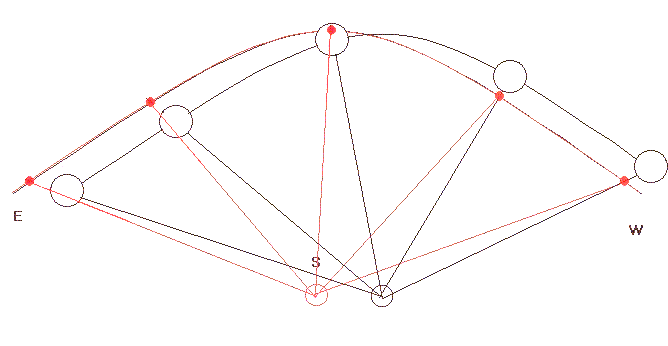
What this rather messy picture is showing, is that, like the star that always stays the
same distance from it's Celestial axis, the telescope is going to also remain the same
distance from it's own axis, improperly aligned or not. In this case, the scope was
set to point at zero degrees in Declination. However, no matter what the declination
had been set to, the scope would still rotate around it's axis in the same manner.
NOTE!: This also is a good image to use to re-emphasize what was said earlier about what is meant by "Up/Down", "North/South" as relates to the view in the telescope.
Since the scope tube rotates around it's Polar axis as it moves from the East to the West, the "Up", or "North" part of the telescope is that part which is directly AWAY FROM the Polar axis of the scope (toward the "top" of the scope) , and the "down", or "South" refer to that part of the tube which points directly TOWARD the Polar axis of the scope (toward the wedge)! Therefore, a "drift" of a star that seems to "drift down", will apparently drift TOWARD the Polar Axis. Don't confuse these directions as referring to the "up/down" of this page!
The beginnings of seeing some "drift" in the star is becoming apparent, but in reality we'd be a bit more refined that this. When we wish to check and adjust our telescope for being out of alignment in an East/West direction, we would actually select a star that is within 10 degrees or so in Declination from the Celestial Equator and perhaps within 20 or so minutes in Right Ascension of our meridian. That's where this particular error will be most apparent, especially when we use a high powered eyepiece and the error is only slight.

This is a more realistic view of the section of sky that you'd be watching,
to check for Polar mis-alignment in an East/West direction. As you can see, as the scope follows
the star in Right Ascension, the star slowly "drifts" toward the Southern Celestial
Pole... or "down" in our eyepiece, regardless on whether we're somewhat on the East or
West side of the meridian.
This gives us rule number one for drift alignment: If a star near the meridian drifts SOUTH (down) in the eyepiece of the telescope, the SOUTHERN direction on our telescope axis is too far WEST of the SOUTH Celestial Pole, and the NORTHERN direction on our telescope axis is too far EAST of the NORTH Celestial Pole!

Here we have the same section of the sky selected, and we're watching the same star, but in this case the Southern Pole of the scope is EAST of the Southern Celestial Pole. The star, as it progresses West, drifts NORTH (Up) in the field of view, AWAY from the Southern Celestial Pole.
This gives us rule number two for drift alignment: If a star near the meridian drifts NORTH (up) in the eyepiece of the telescope, the SOUTHERN direction on our telescope axis is too far EAST of the SOUTH Celestial Pole, and the NORTHERN direction on our telescope axis is too far WEST of the NORTH Celestial Pole!
NOTE! Be very careful, because many manuals and instructions will be talking about the NORTHERN pole mis-alignment, and you may well be thinking SOUTHERN alignment because that's the direction you're looking!!
More important than the rules to be memorized, I hope that the reason the rules apply, makes sense to you!
NOTE #2! You can easily get confused about which way the star is drifting, simply because your setup may or may not cause an inverted image. To be sure, once you see a direction drift, just gently nudge the bottom of the optical tube UP a little, and see if that makes the star move "South" according to your interpretation. It had better, because you just nudged the tube NORTH!
NOTE #3! When you set about adjusting the East/West adjustment on your wedge, be certain as to which way to turn the knob! It's all too easy to be thinking backward and turn it in the wrong direction. Think about it for a bit, before you make the adjustment!
The First Two Rules for the Southern Hemisphere.

Here we see a similar drawing as the previous one, except a person in the Southern Hemisphere would be looking NORTH to see the Celestial Equator, and it's the NORTH Celestial Pole and the NORTH polar axis of his scope that's in front of him and below the horizon. The SOUTH Celestial Pole, of course, is behind him and up. Also, the alignment star, which is rising from the East, will be moving from the observers RIGHT (East) to his LEFT (West).
In this example, the Polar axis is EAST (Right) of the North Celestial Pole. The star, as it is watched, will drift UPWARD (South) in the eyepiece.
Southern Hemisphere rules #1/2
Rule number ONE for drift alignment in the Southern Hemisphere:
If a star near the meridian drifts UPWARD (South) in the eyepiece of the
telescope, the NORTHERN direction on our telescope axis is too far EAST (Right)
of the NORTH Celestial Pole, and the SOUTHERN direction on our telescope axis
is too far WEST (Left) of the SOUTHERN Celestial Pole!
Rule number TWO for drift alignment in the Southern Hemisphere:
If a star near the meridian drifts DOWNWARD (North) in the eyepiece of the
telescope, the NORTHERN direction on our telescope axis is too far WEST (Left)
of the NORTH Celestial Pole, and the SOUTHERN direction on our
telescope axis is too far EAST (Right) of the SOUTH Celestial
Pole!
Back to the Northern Hemisphere.
Once again we're back at our scope. And once again, unknown to us, it isn't really properly polar aligned as we had hoped. Instead, we have the following condition:
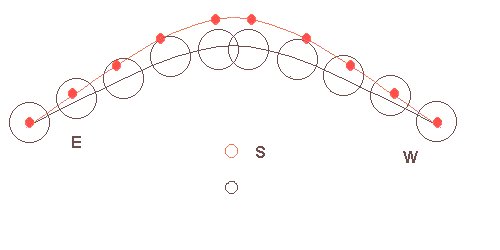
What we're faced with this time is a condition in which, as we face South, the Southern pole on our scope is BELOW the Southern Celestial Pole.... or put another way, our Northern pole of the scope is ABOVE the Northern Celestial Pole.If we watch for "drift" of a star that is rising in the East, we can see that there's going to be a significant drift AWAY from the Southern Celestial Pole, or a NORTHERN (Upward) drift. If instead, we use a star that's setting in the West, the star seems to drift TOWARD the Southern Pole, or a SOUTHERN (Downward) drift.
Either direction, near the East or West horizon, can be used for checking our up/down error. It depends strictly on your choice, which is usually determined by which one will give you the best view. Your East horizon may be blocked by houses or trees. If so, just use the Western section of the sky, but always try to be fairly near the Celestial Equator. You simply must remember which direction of star drift goes with which horizon.
This gives us rule number THREE for drift alignment:
If a star near the EAST horizon drifts UPWARD (North) in the eyepiece
of the telescope, the SOUTHERN direction on our telescope axis is too far SOUTH
of the SOUTH Celestial Pole, and the NORTHERN direction on our telescope axis
is too far NORTH of the NORTH Celestial Pole!
Why is it recommended that all of your drift checks be made near the Celestial Equator? Won't some other area of the sky also show the error drift? The answer is, yes it will. The reason the Celestial Equator is chosen, is because that area of the sky will show the error much more quickly. Zero degrees in Declination ... the Celestial Equator ... has the biggest "diameter" of all of the Declination circles, so the drift error can be detected more quickly or more accurately.
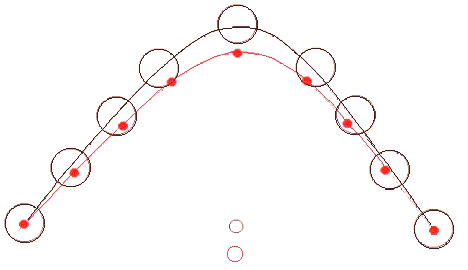
It should come as no surprise to find out that when the South pole on the telescope is ABOVE the Southern Celestial pole, exactly the opposite conditions exist, so we have exactly the opposite directions of drift near the Eastern or Western horizon. The trick is, to be able to remember or figure out which is which.
This gives us rule number FOUR for drift alignment: If a star near the EAST horizon drifts DOWN (South) in the eyepiece of the telescope, the SOUTHERN direction on our telescope axis is too far NORTH of the SOUTH Celestial Pole, and the NORTHERN direction on our telescope axis is too far SOUTH of the NORTH Celestial Pole!
Note: In reality, it's best to select a star that's perhaps twenty degrees or so above the horizon for your testing. Your image is less likely to be distorted by heat waves from the Earth, or just plain poor "seeing" in general.
A Quick trip back to the Southern Hemisphere.
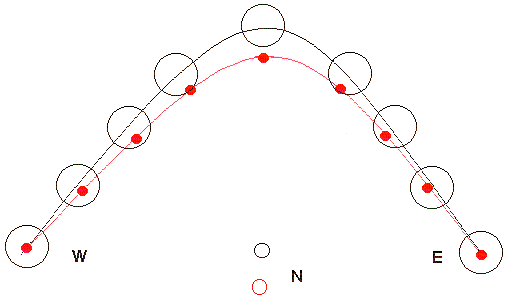
Once again, we are looking North toward a star near the Celestial Equator, and we again are looking for the star to be fairly near either the Eastern or Western Horizon. In this example, we see that the Polar axis of the scope is ABOVE the NORTHERN Celestial Pole, or BELOW the SOUTHERN Celestial Pole, which is behind us. In this case, if the star we use is near the EAST horizon, the star will drift DOWN (North) in the eyepiece. If we are using the star that's near the WEST horizon, it will drift UP (South) in the eyepiece.
From what we've already covered about the actions in the Northern Hemisphere, added to the above information, we can state the next two rules for drift alignment in the Southern Hemisphere:
The Next Two Rules forthe Southern Hemisphere.
Rule number THREE for drift alignment:
If a star near the EAST horizon drifts DOWN (North) in the
eyepiece of the telescope, the NORTHERN direction on our telescope axis is too
far ABOVE the NORTH Celestial Pole, and the SOUTHERN direction on
our telescope axis is too far BELOW the SOUTHERN Celestial Pole!
Rule number FOUR for drift alignment:
If a star near the EAST horizon drifts UP (South) in the eyepiece of the
telescope, the NORTHERN direction on our telescope axis is too far BELOW
of the NORTHERN Celestial Pole, and the SOUTHERN direction on our telescope
axis is too far ABOVE the SOUTHERN Celestial Pole!
Tying it all together
You've seen how to detect and correct the various "drifts" of a star for drift alignment. There are a few real world facts that should also be pointed out.
First, the best way for you to detect drift is to be using an illuminated crosshair eyepiece. Have the crosshairs aligned such that one set is parallel to the East/West movement of the telescope. Do this by centering the alignment star, then running the scope back and forth in Right Ascension to be sure the star stays close to parallel to the crosshair. That way, a relatively small movement in Declination can easily be detected.
Another method that's often used if you don't have the illuminated eyepiece, is to position the scope so that the star you're observing is positioned at either the Northern or Southern edge of the field of view in a conventional eyepiece. That way, you can detect the North/South drift, seeing the small drift effects on the star.
Second, do not... NOT... worry about "drift" in Right Ascension. That has nothing whatsoever to do with Polar alignment, but simply has to do with the drive characteristics of your R.A. motor. In fact, what you may well want to do is to "guide" on the alignment star in R.A., and hold it near the center of the crosshairs... or the edge of the field of view.... depending on the method used.
Third, once you've been through the two alignments, left/right, up/down, go right back to the beginning and repeat the procedure. Unless you have your wedge PERFECTLY level.... not likely ... there will be interaction between the two adjustments. That is, when you go back to the left/right adjustment, even though you thought you had it perfect the first time, it in all likelihood will need a small amount of re-adjustment. Likewise after you've made this small adjustment. It probably will have effected the up/down adjustment that you've just done. Don't be surprised about it, and don't let it irritate you. It's the nature of the beast.
Now, because of the fact that you'll most likely be going back and forth between the two adjustments, getting closer each time, it's easier on your nerves if you don't spend a lot of time on one particular directional adjustment before going to the other one. You'll be ping-ponging between these two adjustments, if you're trying to get the drift down to as close to zero as you can. If you keep going back to, say, the adjustment for left/right alignment of the pole that you're using as a reference, and finally get it to ideal, you may want to pull your hair out when you find that you have to go back and "tweak" this adjustment again!
It's probably better, as you near the "ideal" settings, to make a very small correction, watch it once to make sure you improved it some, then go to the other check and do the same. That way, both adjustments will slowly get closer and closer to ideal, at the same time (This is strictly a personal opinion, based on my own experiences, and you may not agree with it at all.)Finally, there is a matter of "how good must the adjustments be?" That's really a subjective matter. Naturally, in the ideal world, the answer would be that anything less than perfect isn't good enough. But, at least where I do MY imaging, it's far from the ideal world!
If a person is doing strictly viewing, then Polar alignment isn't critical at all, so long as your "go to" feature, if you have one, functions adequately. For astrophotography or CCD imaging, it's quite another matter. In my personal opinion, if a person has a permanent mount, then it's worthwhile to spend an evening every few months, to get the drift down to the minimum they can get, no matter what the scope application might be. Under these conditions, a star viewed with high power would show no visible drift after 15 minutes or so.
On the other hand, if you are moving the telescope between viewing sessions, the limiting factor is all too often, the time it takes to get the drift minimized. One doesn't want to spend most of the evening making Polar adjustments, only to have a short part of the evening left for imaging or photographing.
Even then, the amount of tolerable drift is going to vary with the type of imaging you do. If you take a lot of relatively short, unguided images, then the accuracy of the adjustments would probably be determined by the field rotation one gets, while taking a full series of images of the same object.
If, on the other hand, you self guide or auto guide, the factors to consider are going to be not only potential field rotation, but the extra work of guiding in both R.A. and Dec. For a camera with self guide, your images will certainly turn out better if you don't require Dec corrections in your longest shot. Otherwise, you're potentially faced with camera over-correction, which can lead to trailed star images.
As you can see, on this subject, I leave it mostly up to the user. That's the person that has to consider all factors, and by experience with time, will determine for themselves what the accuracy needed will be. As for me, I have a permanent mount for my telescope, and I try to make sure that when doing CCD imaging, my self-guiding camera NEVER has to make Dec corrections. Instead of using an eyepiece for determining the drift of a star, I simply select the star, begin to "self guide"; with the Dec corrections turned off, and assure myself that after 15 minutes or so, there has been no more than approximately 1.5 arc seconds of drift in Dec. That's usually good enough, for me at least.

